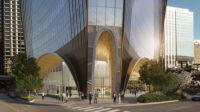A California seismic-retrofit mandate for hospitals has produced a wave of major projects over the past several years, giving a welcome lift to the state's architectural and engineering firms. But as the program's first major deadline draws near, the wave of hospital work has receded. To cope with the decline in the health care sector, many A/E firms are branching out to new regions or offering a wider range of services to potential clients.
Combined revenue for this year's top 10 design firms rose a modest 2.6% over the total for last year's top 10. Firms also indicate that their expansion strategies have begun to make a difference.
This year's Top Design Firms ranking repeats a trend from last year: By a large margin, most of the top 10 firms' large projects that broke ground were funded by government agencies—federal, state, city or county. The list includes a new Long Beach courthouse, a Los Angeles Expo light-rail line extension, a San Francisco Public Utilities Commission headquarters, a naval hospital at Camp Pendleton and the Transbay Transit Center in San Francisco.
Jan. 1, 2013, is the initial deadline for complying with state Senate Bill 1953, the 1994 statute requiring all 450 acute-care hospitals in California to evaluate their facilities' seismic conditions and, if warranted, plan renovations and replacements. That law sparked a boom in health care design and construction, but now the hospital work is "winding down," says Bill Diefenbach, senior vice president and California office director for SmithGroupJJR.
Health care projects have not disappeared. For example, after a long waiting period, the California Pacific Medical Center (CPMC) hospital at Cathedral Hill in San Francisco may soon break ground. In 2003, SmithGroupJJR and Skidmore, Owings & Merrill LLP were retained as a joint venture with SMWM to begin initial designs for the 555-bed hospital and medical office building at Van Ness Avenue and Geary Street. In 2006, the team was disbanded and SmithGroupJJR was retained to develop a scaled-back project.
The team got good news in April, when the San Francisco planning commission approved the current design and construction plans for the hospital and for three other CPMC projects in the city. The cost of the total plan is $2.5 billion. The last hurdle is getting approval by the city board of supervisors. (As of press time, no date has been set for a vote.)
But few other health care projects are waiting in the wings. Diefenbach says, "Obviously, it takes an enormous amount of smaller projects to make up for a large hospital replacement." To compensate for the California hospital sector downturn, some design firms working in the Golden State are looking to other markets. For example, SmithGroupJJR is expanding overseas, to China, India and South America.
Cannon Design also is pursuing more work outside the U.S. Michael J. Smith, principal/Western region market and operations leader in the Los Angeles office, says, "These projects included an automobile factory in India, a performing arts center in Inner Mongolia and a high-rise laboratory in South Korea." Smith says the firm also broadened its services to include mechanical, electrical and plumbing engineering, facility-optimization services, operational-strategies consulting and interior and product design. He adds,"We've also established a research group that has enabled us to develop new technology, such as responsive exterior skins."
Smith sees fewer megaprojects on the horizon in the institutional market "and a lot more renovation work and backfill projects than we've seen in the past years."
At CO Architects, academic and higher-education projects traditionally have been a core business. But as state and local budget worries squeeze construction funds, design firms need to be more proactive, says Scott Kelsey, managing principal in Los Angeles.







Post a comment to this article
Report Abusive Comment